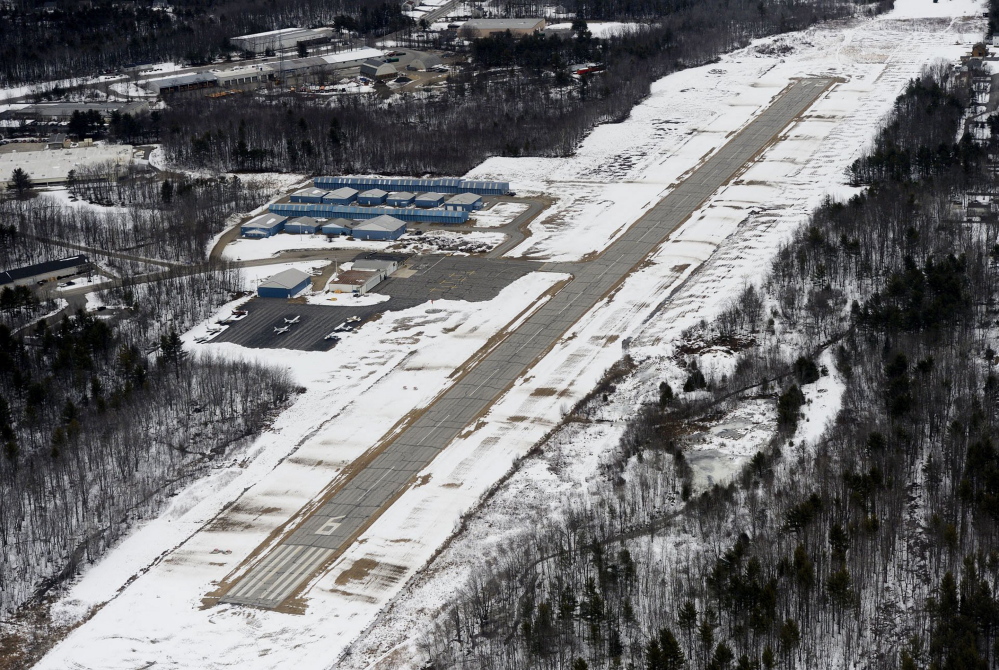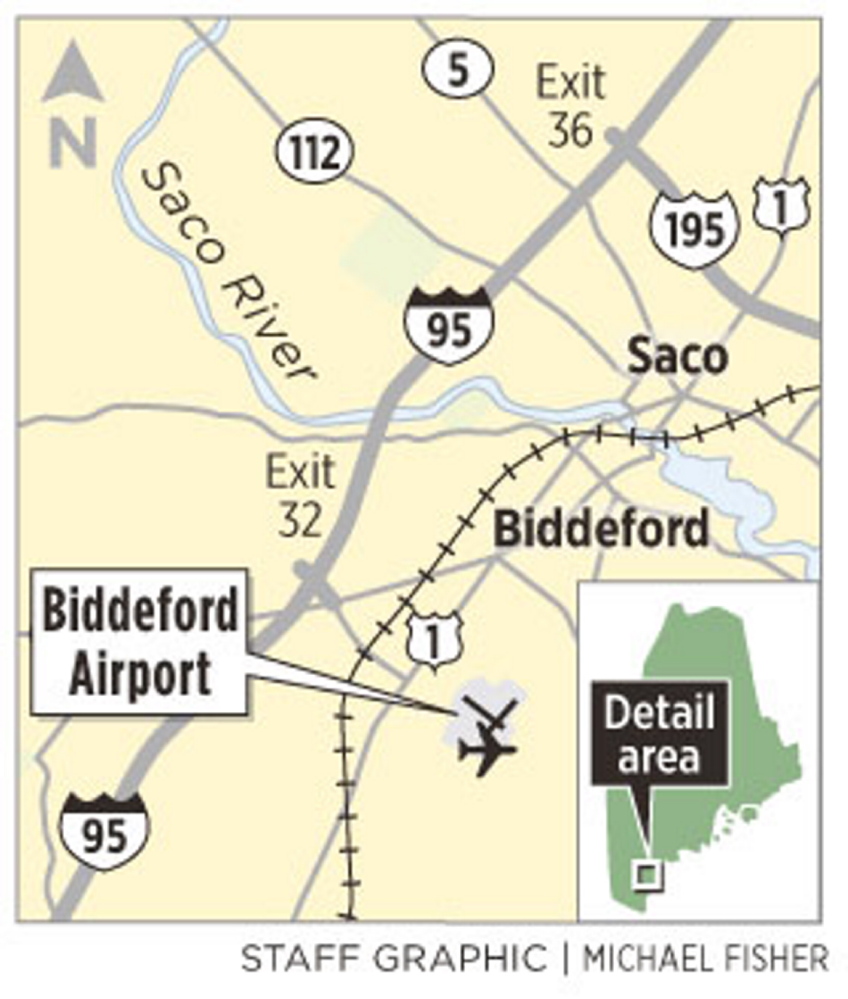A plan to trim trees next to the 80-year-old Biddeford Municipal Airport has turned into the latest flashpoint in a long-running debate about the future of the city-owned facility.
The City Council, seemingly split over whether to accept more than $900,000 in state and federal funding to trim the trees and construct a safety area near the runway, has delayed making a decision while councilors seek more information about the economic impact of the small airport.
The Federal Aviation Administration, meanwhile, has notified the city it must act because trees have grown up around the runway, forcing some pilots to land and depart at unsafe angles.
While city officials are concerned about safety and the potential legal liability if the trees contribute to an accident, they face opposition from neighbors who fear their properties will be clearcut and the airport expanded.
Mayor Alan Casavant said the airport has been in limbo for six years, even though the city appeared to resolve doubts about the future of the airport in 2008, when 80 percent of residents voted against closing it.
“It’s turned into a political drama that is never-ending,” Councilor Bob Mills said during a recent council discussion.
The municipal airport, built on Landry Street in the 1930s, now includes a 3,011-foot runway and 30 private hangars. About 40 planes are based at the airport, which has no control tower.
The Biddeford airport is one of 36 public airports in Maine, said Scott Rollins, the state aviation director with the Maine Department of Transportation. Many of the airports were built during wartime and later kept open by municipalities, he said.
A study by the Department of Transportation showed that Biddeford’s airport generated $3.6 million in direct and indirect economic activity in 2006, although those numbers are questioned by critics of the airport and by several city councilors. Rollins said the state plans to do another study in 2016.
There are about 6,000 flights each year at the Biddeford airport, according to data collected by the Department of Transportation. The airport is used primarily by local pilots flying for business and pleasure.
The Portland International Jetport, the state’s busiest airport, had more than 60,000 flights in 2010.
Biddeford expects to spend about $215,000 this year to run the airport and expects to take in just over $184,000 in revenue from fuel sales, hangar rentals and storage fees.
Pilots who fly small planes in and out of the airport have urged city officials to trim the trees and to continue investing in the facility.
“It is sad to see a city asset go to waste because of a few bad apples (neighbors). It was clear in 2008 that the city did not want it to close down,” Marcel Bertrand, a pilot who uses the airport for his business, Arundel Machine, wrote in a letter to city officials.
Paul Archambault, who has lived near the airport on Breton Street since the mid-1980s, said a lack of communication between airport and city officials and residents in the neighborhood near the airport has grown worse in the past decade. The city has easements on properties in the neighborhood that allow the city to remove obstructions, but residents fear the city will clear-cut their lots, he said. Residents say the trees provide a buffer between the neighborhood and the airport, and their removal would negatively affect their property values.
Archambault and several neighbors led the unsuccessful campaign to shut down the airport in 2008. At the time, city officials estimated that closing the airport would cost $3 million because the city would have to pay back federal grants and relocate hangars to another airport.
“Until such time that the residents and those people with properties that have easements can be assured the city won’t come in and bulldoze properties, we continue to push for extreme measures like closure because we don’t have any other recourse,” Archambault said.
Casavant, who last year reinstated the Airport Commission to address what he called lagging safety and maintenance, said he understands the concerns of the neighbors but feels an obligation to honor the vote not to close the airport.
“It’s a ‘not-in-my-backyard’ argument” against the project, he said. “It’s the same people who show up each time with the same point of view. It’s like the movie ‘Groundhog Day.’ It always comes back and it’s the same argument.”
Casavant sees the airport as a valuable part of the city’s infrastructure that could attract businesses, especially at a time when the redevelopment of the downtown and mill district are attracting large investments. The city recently approved a $50 million plan to convert a mill into a hotel and restaurants, and officials are studying how to redevelop the waterfront site of a former downtown trash incinerator.
“The airport can be an asset as far as marketing this community,” Airport Commission member Fred Oliver told the council.
Last week, the City Council tabled an order to authorize the city manager to accept more than $866,000 from the FAA and about $48,000 from the Maine Department of Transportation to pay to trim trees the FAA has said are an obstruction. The city would contribute $48,000, or 5 percent of the project’s total cost.
In addition to trimming trees, the overall cost estimate includes $125,000 to acquire a 42-acre parcel of land from the New England Electric Railway that will allow the city to construct a safety area near the runway.
According to the FAA, the severe angles that pilots have to use to avoid the treetops create safety concerns at night and during low visibility conditions.
Councilor Brad Cote, who made the motion to table the vote, said he wants more information about the economic impact of the airport and an accurate count of how many planes regularly use it.
“I can’t see putting any more money into the airport until we have the data and can make an educated decision,” Cote said at the Feb. 3 City Council meeting.
Cote said he does want the airport to be safe, “but I don’t necessarily want to keep throwing money into a black hole.”
He would like the City Council to talk about the possibility of hiring an outside consultant to look at the airport.
City Manager John Bubier said he got one cost estimate of $27,000 for such an economic study, which the council would have to authorize.
Councilor Mills, on the other hand, said he would like to see the council finally secure the grant money for the project.
“We have to keep this airport safe, not only just for the pilots and people who use it, but for the residents who live around it,” he said.
Councilor Michael Ready agreed. “Whether we decide in the future that we don’t want an airport there, we have one now,” Ready said. “We have an obligation to maintain it safely and it doesn’t seem we’re meeting that minimum threshold.”
Casavant said he will put the issue back on the agenda for the Feb. 17 City Council meeting and he would like to see the council vote on the plan.
“We have to come to some determination about where we’re going to go,” he said. “To do nothing and vacillate, that’s a problem.”
Copy the Story LinkSend questions/comments to the editors.





Success. Please wait for the page to reload. If the page does not reload within 5 seconds, please refresh the page.
Enter your email and password to access comments.
Hi, to comment on stories you must . This profile is in addition to your subscription and website login.
Already have a commenting profile? .
Invalid username/password.
Please check your email to confirm and complete your registration.
Only subscribers are eligible to post comments. Please subscribe or login first for digital access. Here’s why.
Use the form below to reset your password. When you've submitted your account email, we will send an email with a reset code.